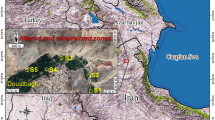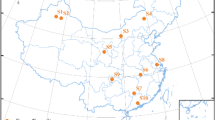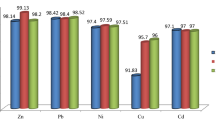Abstract
The distribution of heavy metals (Cu and Zn) and their geochemical speciation (exchangeable fraction, carbonate fraction, Fe/Mn oxide fraction, organic fraction and residual fraction) in wetland soils of Poyang Lake were examined by modified Tessier sequential extraction methods. The results showed that the Cu and Zn concentrations in the wetland soils were 6.83–342.54 mg·kg−1 and 34.39–195.36 mg·kg−1, respectively. The highest heavy metal concentrations were found in the wetland soils located in the lower reaches of mines and metal smelters. The metal speciation analysis showed that Cu and Zn were mainly linked to the residual fraction in all samples which account for 65.64% and 68.14%, respectively. The content of the exchangeable fraction (Cu 1.00%, Zn 3.60%) and carbonate fraction (Cu 2.09%, Zn 1.53%) was generally lower. Assessments of pollution levels revealed that Cu and Zn were much higher than their background value and heavy metal pollution in the wetland soils located in the lower reaches of mines and metal smelters was often more severe. The sites Duchang and Hukou were least polluted by Cu and Zn.



Similar content being viewed by others
References
Ahlf W, Drost W, Heise S (2009) Incorporation of metal bioavailability into regulatory frameworks-metal exposure in water and sediment. J Soils Sediments 9:411–419
Akcay H, Oguz A, Karapire C (2003) Study of heavy metal pollution and speciation in Buyak Menderes and Gediz river sediments. Water Res 37:813–822
Anju M, Banerjee DK (2010) Comparison of two sequential extraction procedures for heavy metal partitioning in mine tailings. Chemosphere 78(11):1393–1402
Bai JH, Xiao R, Cui BS, Zhang KJ, Wang QG, Liu XH, Gao HF, Huang LB (2011) Assessment of heavy metal pollution in wetland soils from the young and old reclaimed regions in the Pearl River estuary, South China. Environ Pollut 159:817–824
Bai JH, Xiao R, Zhang KJ, Gao HF (2012) Arsenic and heavy metal pollution in wetland soils from tidal freshwater and salt marshes before and after the flow-sediment regulation regime in the Yellow River Delta, China. J Hydrol 450-451:244–253
Batchman TM, Friese K, Zachmann DW (2001) Redox and pH conditions in the water column and in the sediments of an acidic mining lake. J Geochem Explor 73:75–86
Chen SY, Lin JG (2001) Bioleaching of heavy metals from sediment: significance of pH. Chemosphere 44:1093–1102
Chen H, Chen R, Teng Y, Wu J (2016) Contamination characteristics, ecological risk and source identification of trace metals in sediments of the Le'an river (China). Ecotoxicol Environ Saf 125:85–92
Cui BS, He Q, Gu BH, Bai JH, Liu XH (2016) China’s coastal wetlands: understanding environmental changes and human impacts for management and conservation. Wetlands 36(Suppl 1):S1–S9
Davutluoglu IO, Seckın G, Kalat DG, Yılmaz T, Ersu CB (2010) Speciation and implications of heavy metal content in surface sediments of Akyatan lagoon –Turkey. Desalination 260:199–210
Díaz-de Alba M, Galindo-Riano MD, Casanueva-Marenco MJ, García-Vargas M, Kosore CM (2011) Assessment of the metal pollution, potential toxicity and speciation of sediment from Algeciras Bay (south of Spain) using chemometric tools. J Hazard Mater 190:177–187
Gale NL, Adams CD, Wixson BG, Loftin KA, Huang YW (2004) Lead, zinc, copper, and cadmium in fish and sediments from the big river and Flat River creek of Missouri's old lead belt. Environ Geochem Health 26:37–49
Garg J (2015) Wetland assessment, monitoring and management in India using geospatial techniques. J Environ Manag 148:112–123
Hamiani OE, Khalil HE, Lounate K, Sirguey C, Hafidi M, Bitton G, Schwartz C, Boularbah A (2010) Toxicity assessment of garden soils in the vicinity of mining areas in southern Morocco. J Hazard Mater 177:755–761
He M, Wang Z, Tang H (1997) Spatial and temporal patterns of acidity and heavy metals in predicting the potential for ecological impact on the le an river polluted by acid mine drainage. Sci Total Environ 206(1):67–77
Huang J, Yuan F, Zeng G, Li X, Gu Y, Shi L, Liu W, Shi Y (2017) Influence of pH on heavy metal speciation and removal from wastewater using micellar-enhanced ultrafiltration. Chemosphere 173:199–206
Hui FM, Xu B, Huang HB, Yu Q, Gong P (2008) Modelling spatial-temporal change of Poyang Lake using multi temporal landsat imagery. Int J Remote Sens 29:5767–5784
Iqbal J, Shah MH (2011) Distribution, correlation and risk assessment of selected metals in urban soils from Islamabad, Pakistan. J Hazard Mater 192:887–898
Islam MS, Ahmed MK, Raknuzzaman M, Mamun MHA, Islam MK (2015) Heavy metal pollution in surface water and sediment: a preliminary assessment of an urban river in a developing country. Ecol Indic 48:282–291
Jia YF, Jiao SW, Zhang YM, Zhou Y, Lei GC, Liu GH (2013) Diet shift and its impact on foraging behavior of Siberian crane (Grus leucogeranus) in Poyang Lake. PLoS One 8(6):1–9
Jiang HB, Wen Y, Zou LF, Wang ZQ, He CG, Zou CL (2016) The effects of a wetland restoration project on the Siberian crane (Grus leucogeranus) population and stopover habitat in momoge national nature reserve, china. Ecology Engineering 96:170–177
Kashem MA, Singh BR (2001) Metal availability in contaminated soils: II. Uptake of cd, Ni and Zn in rice plants grown under flooded culture with organic matter addition. Nutr Cycl Agroecosyst 61(3):257–266
Knox SH, Dronova I, Sturtevant C, Oikawa PY, Matthes JH, Verfaillie J, Baldocchi D (2017) Using digital camera and Landsat imagery with eddy covariance data to model gross primary production in restored wetlands. Agric For Meteorol 237–238:233–245
Kumpiene J, Lagerkvist A, Maurice C (2008) Stabilization of as, Cr, cu, Pb and Zn in soil using amendments—a review. Waste Manag 28:215–225
Kwon JC, Nejad ZD, Jung MC (2017) Arsenic and heavy metals in paddy soil and polished rice contaminated by mining activities in Korea. Catena 148:92–100
Laing DG, Rinklebe J, Vandecasteele B, Meers E, Tack FMG (2009) Trace metal behaviour in estuarine and riverine floodplain soils and sediments: a review. Sci Total Environ 407:3972–3985
Li Z, Ma Z, van der Kuijp TJ, Yuan Z, Huang L (2014) A review of soil heavy metal pollution from mines in China: pollution and health risk assessment. Sci Total Environ 468:843–853
Linnik PM, Zubenko IB (2000) Role of bottom sediments in the secondary pollution of aquatic environments by heavy metal compounds. Lakes Reserv Res Manag 5:11–21
Liu YS, Ma LL, Li YQ, Zheng LT (2007) Evolution of heavy metal speciation during the aerobic composting process of sewage sludge. Chemosphere 67(5):1025–1032
Lu QQ, Bai JH, Gao ZQ, Zhao QQ, Wang JJ (2016) Spatial and seasonal distribution and risk assessments for metals in a Tamarix chinensis wetland, China. Wetlands 36:125–136
Luo MB, LQ J, Cao WP, Wang ML (2008) Study of heavy metal speciation in branch sediments of Poyang Lake. J Environ Sci 20(2):161–166
Matagi SV, Swai D, Mugabe R (1998) A review of heavy metal removal mechanisms in wetlands. Afr J Trop Hydrobiol Fish 8:23–35
Melly BL, Schael DM, Gama PT (2017) Perched wetlands: an explanation to wetland formation in semi-arid areas. J Arid Environ 141:34–39
Ministry of agriculture, animal husbandry and fishery, People's Republic of China (1987) GB 7172–87, method for the determination of soil water content. China Standard Press, Beijing
Mitsch WJ, Gosselink JG (2000) Wetlands. John Wiley & Sons, New York
Modak DP, Singh KP, Chandra H, Ray PK (1992) Mobile and bound forms of trace metals in sediments of the lower Ganges. Water Res 26(11):1541–1548
Muller G (1969) Index of geoaccumulation in sediments of the Rhine River. The Journal of Geology 2:108–118
Nemati K, Abu Bakar NK, Radzi Abas M, Sobhanzadeh E (2011) Speciation of heavy metals by modified BCR sequential extraction procedure in different depths of sediments from Sungai Buloh, Selangor, Malaysia. J Hazard Mater 192:402–410
Oyuela Leguizamo MA, Fernández Gómez WD, Sarmiento MCG (2017) Native herbaceous plant species with potential use in phytoremediation of heavy metals, spotlight on wetlands — a review. Chemosphere 168:1230–1247
Pardo R, Barrado E, Perez L, Vega M (1990) Determination and association of heavy metals in sediments of the Pisucrga, river. Water Res 24(3):373–379
Passos EA, Alves JC, Santos IS, Alves JP, Garcia CAB, Costa ACS (2010) Assessment of trace metals contamination in estuarine sediments using a sequential extraction technique and principal component analysis. Microchem J 96:50–57
Pejman A, Nabi Bidhendi G, Ardestani M, Saeedi M, Baghvand A (2017) Fractionation of heavy metals in sediments and assessment of their availability risk: a case study in the northwestern of Persian gulf. Mar Pollut Bull 114(2):881–887
Radojevic M, Bashkin VM (1999) Practical environmental analysis. Royal Society of Chemistry, Cambridge
Rennert T, Meibner S, Rinklebe J, Totsche KU (2010) Dissolved inorganic contaminants in a floodplain soil: comparison of in situ soil solutions and laboratory methods. Water Air Soil Pollut 209:489–500
Rodríguez L, Ruiz E, Alonso-Azcárate J, Rincón J (2009) Heavy metal distribution and chemical speciation in tailings and soils around a Pb-Zn mine in Spain. J Environ Manag 90:1106–1116
Salomons W, Förstner U (1980) Trace metal analysis on polluted sediments. Part II: evaluation of environmental impact. Environmental Technology Letter 1:506–517
Shankman D, Keim BD, Song J (2006) Flood frequency in China's Poyang Lake region: trends and teleconnections. Int J Climatol 26:1255–1266
Singh KP, Mohan D, Singh VK, Malik A (2005) Studies on distribution and fractionation of heavy metals in Gomti river sediments-a tributary of the Ganges, India. J Hydrol 312:14–27
Sundaray SK, Nayak BB, Lin S, Bhatta D (2011) Geochemical speciation and risk assessment of heavy metals in the river estuarine sediments-case study: Mahanadi basin, India. J Hazard Mater 186:1837–1846
Teasdale PR, Apte SC, Ford PW, Batley GE, Koehnken L (2003) Geochemical cycling and speciation of copper in waters and sediments of Macquarie harbour, western Tasmania. Estuar Coast Shelf Sci 57:475–487
Tessier A, Campbell PGC, Bisson M (1979) Sequential extraction procedure for the speciation of particulate trace metals. Anal Chem 51:844–851
Tüzen M (2003) Determination of trace metals in the river Yeşilırmak sediments in Tokat, Turkey using sequential extraction procedure. Microchem J 74:105–110
Wang H, Zhao Y, Liang D, Deng Y, Pang Y (2017) 30+ year evolution of cu in the surface sediment of Lake Poyang, China. Chemosphere 168:1604–1612
Xiao R, Wang S, Li RH, Wang JJ, Zhang ZQ (2017) Soil heavy metal contamination and health risks associated with artisanal gold mining in Tongguan, Shaanxi, China. Ecotoxicol Environ Saf 141:17–24
Xu D, Xiong M, Zhang J (2001) Analysis on hydrologic characteristics of Poyang Lake. Yangtze River 32(2):21–27 (in Chinese with English abstract)
Yang J, Chen L, Liu LZ, Shi WL, Meng XZ (2014) Comprehensive risk assessment of heavy metals in lake sediment from public parks in Shanghai. Ecotoxicol Environ Saf 102:129–135
Yao XY, Xiao R, Ma ZW, Xie Y, Zhang MX, Yu FH (2016) Distribution and contamination assessment of heavy metals in soils from tidal flat, oil exploitation zone and restored wetland in the Yellow River estuary. Wetlands 36(1):153–165
Yu YX, Wang H, Li Q, Wang B, Yan ZH, Ding AZ (2016) Exposure risk of rural residents to copper in the Le’an River Basin, Jiangxi Province, China. Sci Total Environ 548–549:402–407
Yuan GL, Liu C, Chen L, Yang Z (2011) Inputting history of heavy metals into the inland lake recorded in sediment profiles: Poyang lake in China. J Hazard Mater 185:336–345
Zhang B, Lu ZG, Zhu HF (1988) Studies on Poyang Lake. Shanghai Science and Technology Press, Shanghai, p 40
Zhang DW, Wei YH, Zhang L, Lin GG, Chen YW, Tu TT (2012) Distribution of heavy metals in water, suspended particulate matter and sediment of Poyang lake, China. Fresenius Environ Bull 21:1910–1919
Zhang C, Shan B, Tang W, Dong L, Zhang W, Pei Y (2017) Heavy metal concentrations and speciation in riverine sediments and the risks posed in three urban belts in the Haihe Basin. Ecotoxicol Environ Saf 139:263–271
Acknowledgements
The research work Supported by the National Natural Science Foundation of China (NO. 41663004), the Open Project Program of the Key Laboratory of Poyang Lake Environment and Resource Utilization Ministry of Education, Nanchang University (NO.PYH2015-02), the Open Project Program of State Key Laboratory of Food Science and Technology, Nanchang University (No. SKLF-KF-201619) and the Natural Science Foundation of Jiangxi Province (NO.20114BAB213023).
Author information
Authors and Affiliations
Corresponding author
Rights and permissions
About this article
Cite this article
Wang, M., Hu, K., Zhang, D. et al. Speciation and Spatial Distribution of Heavy Metals (cu and Zn) in Wetland Soils of Poyang Lake (China) in Wet Seasons. Wetlands 39 (Suppl 1), 89–98 (2019). https://doi.org/10.1007/s13157-017-0917-1
Received:
Accepted:
Published:
Issue Date:
DOI: https://doi.org/10.1007/s13157-017-0917-1




